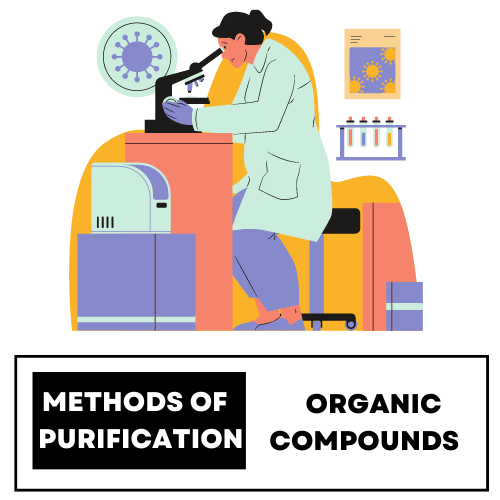
I. Introduction
A. Explanation of organic compounds
Organic compounds are carbon-based molecules that are essential for life and play an important role in the structure and function of living organisms. They are found in a variety of sources, including plants, animals, and microorganisms.
B. Importance of purification of organic compounds
The purification of organic compounds is important because it ensures that the compound is free from impurities that may affect its properties and function. Impurities can alter the chemical, physical, and biological properties of the organic compound, which may affect its use in various applications.
C. Purpose of the blog post
The purpose of this blog post is to provide an overview of the various methods of purifying organic compounds that are commonly used in chemistry, including filtration, crystallization, distillation, sublimation and chromatography.
II. Methods of Purification of Organic Compounds
A. Filtration
Definition of filtration :- Filtration is a method of separating a solid from a liquid or gas using a porous material, such as filter paper, that allows the liquid or gas to pass through but retains the solid.
Types of filtration :- There are several types of filtration, including gravity filtration, vacuum filtration, and hot filtration.
Apparatus used for filtration :- The apparatus used for filtration includes a filter funnel, filter paper, and a collection flask.
B. Crystallization
Definition of crystallization :- Crystallization is a method of purifying a solid by dissolving it in a solvent and then allowing the solvent to evaporate slowly, causing the solid to form crystals.
Types of crystallization :- There are several types of crystallization, including evaporation crystallization, cooling crystallization, and fractional crystallization.
Apparatus used for crystallization :- The apparatus used for crystallization includes a beaker, a hot plate, a stir bar, and a vacuum filtration setup.
C. Distillation
Definition of distillation :- Distillation is a method of separating a mixture of liquids based on their boiling points. The mixture is heated, and the vapors are condensed and collected in a separate container.
Types of distillation :- There are several types of distillation, including simple distillation, fractional distillation, and steam distillation.
Apparatus used for distillation :- The apparatus used for distillation includes a distillation flask, a condenser, a receiving flask, and a heat source.
D. Sublimation
Definition of sublimation :- Sublimation is a method of purifying a solid that involves heating it to a high temperature, causing it to vaporize and then condense on a cool surface as a purified solid.
Apparatus used for sublimation :- The apparatus used for sublimation includes a sublimation flask, a condenser, and a cold finger.
E. Chromatography
Definition of chromatography :- Chromatography is a method of separating and purifying a mixture of compounds based on their chemical properties, such as polarity or size.
Types of chromatography :- There are several types of chromatography, including paper chromatography, thin-layer chromatography, and gas chromatography.
Apparatus used for chromatography :- The apparatus used for chromatography includes a chromatography column, a stationary phase, a mobile phase, and a detector.
III. Conclusion
A. Recap of methods of purification of organic compounds
In conclusion, the methods of purifying organic compounds that are commonly used in chemistry include filtration, crystallization, distillation, sublimation, and chromatography.
Each method has its own advantages and limitations and can be used to purify different types of organic comp
frequently asked questions
Methods of purification are techniques used to remove impurities from chemical compounds. Common methods include simple and fractional distillation, crystallization, sublimation, and chromatography. These methods are essential in producing pure substances for use in various fields, including research, medicine, and industry.
The best purification technique for a compound depends on its properties and impurities. Each method has its advantages and disadvantages. For example, distillation is suitable for separating liquids with different boiling points, while crystallization is effective for purifying solids. Chromatography is a versatile method that can separate complex mixtures. A combination of methods is often used to achieve high levels of purity. Therefore, the best technique for purification depends on the specific needs of the compound and the intended use.
There are various methods for separation and purification of compounds. Distillation is used to separate liquids with different boiling points. Crystallization is used to purify solids. Sublimation is used to separate mixtures of solids with different sublimation points. Chromatography separates complex mixtures by passing them through a stationary phase. Filtration separates a solid from a liquid or gas by using a filter. Centrifugation separates particles based on their density or size. Extraction separates compounds based on their solubility in different solvents. These methods can be used alone or in combination to achieve high levels of purity.
Crystallization is the most commonly used technique for the purification of solid compounds. It involves dissolving the impure compound in a suitable solvent and allowing it to cool slowly, causing the formation of pure crystals while leaving impurities behind in the solution. The crystals are then collected by filtration and washed with a small amount of solvent to remove any remaining impurities. This process can be repeated several times to achieve a high level of purity .
content
🌟 Exploring the Basics of Organic Chemistry: A Guide for 10 to 12 ISCE ; CBSE ; NCERT
